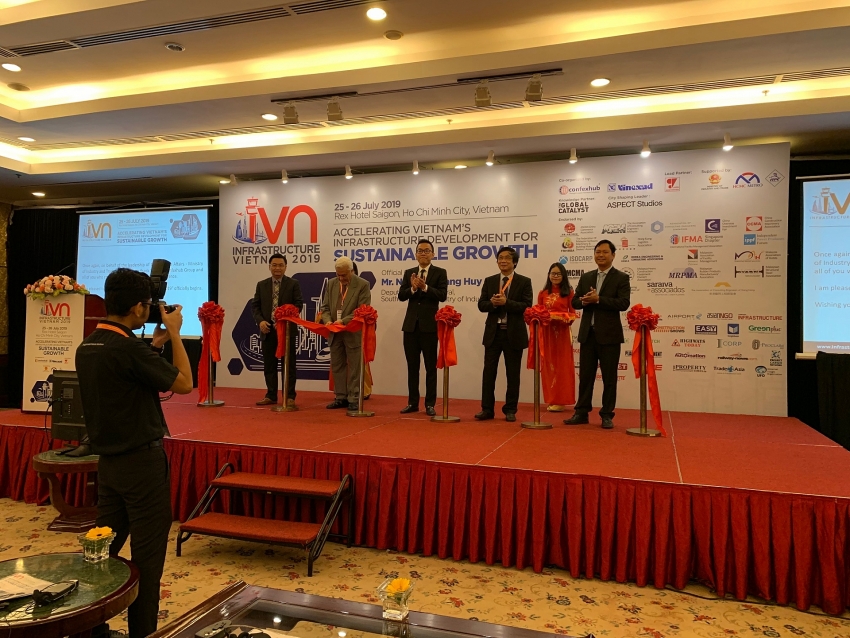Vietnam attracts foreign investment into infrastructure development
 |
| Representatives cut the ribbon to open the seminar |
Co-organised by Vinexad (Ministry of Trade and Industry) and Confexhub from Malaysia, the seminar helped co-ordinate business activities between investors, local policymakers, and officers in charge of infrastructure investment in Vietnam.
The seminar was organised to create opportunities for international trade, attracting investment into infrastructure development in Vietnam to prepare for deepening international integration into the global economy.
Experts at the seminar advised Vietnam to revise its ways of attracting foreign investment and potential partners to meet the demand for infrastructure development.
According to Nguyen Quang Huy, deputy director general, southern affairs under the Ministry of Industry and Trade, the infrastructure system plays an important role in the socio-economic development of any country.
“During the past years, Vietnam has been focusing on infrastructure development to meet the increasing demand of the whole society. The country itself also had been creating remarkable improvements in both the quality and quantity of infrastructure facilities,” said Huy.
Dr Datuk Abdul Aziz Kadir, chairman of Confexhub Group, said that driven by pro-growth policies and the presence of dynamic companies, teh ASEAN has once again positioned itself among the world’s best-performing emerging economies and will be a driving force for the global economy in the coming years.
“However, a substantial lack of infrastructure in many countries in this region has made trade competitiveness much less efficient, and the economic growth less sustainable,” Kadir said.
Vietnam, according to him, was not an exception.
“Although Vietnam has been reported to be one of the nations with the fastest growing GDP in the world, it faces issues in both the quality and quantity of its infrastructure, going far below the country’s needs. Due to the big gap in infrastructure need, Vietnam has a strong project pipeline in roads, rails, bridges, public service infrastructure, urban transportation, and of course, the infrastructure for its ports and special economic zones. According to studies, between 2016 and 2020, Vietnam will need an investment of approximately $38 billion per annum for various socio-economic infrastructure projects. These projects are mostly in transport and power infrastructure, irrigation, water, education, and healthcare,” he said.
Moreover, conventional funding sources from the state budget and official development assistance (ODA) from bilateral and multilateral donors and government bonds can only cover some 50 per cent of the total need. The local capital market, as well as foreign private investors, are expected to step up and contribute to infrastructure investment and development under a Public-Private Partnership (PPP) scheme.
“The Vietnamese government is putting in great efforts to draw investment from the foreign private sector, to attract not only equity but also specialised technical knowledge into these projects. Ongoing regulatory reforms and the privatisation of state-owned enterprises encourage the private sector to maintain and increase their existing level of investment in infrastructure in the country,” he said.
Maxfield Brown, manager of business intelligence at Dezan Shira & Associates, also expressed that the most recent issue of Global Infrastructure Outlook highlights Vietnam committing to its infrastructure investment objectives, with the country projected to meet 83 per cent of its target by 2040.
“In order to get there, Vietnam will nevertheless need $605 billion more in investment. The Vietnam government is set to meet its ambitious goal by liberalising various industries and embracing PPP. The government has been making efforts to introduce private-sector participation in the roads and rail sectors, and actively attracting foreign direct investment to develop its infrastructure needs,” Brown said.
What the stars mean:
★ Poor ★ ★ Promising ★★★ Good ★★★★ Very good ★★★★★ Exceptional
Related Contents
Latest News
More News
- Kolon signs $48 million airbag supply deal with Autoliv (December 15, 2025 | 18:14)
- National Assembly approves Vinh–Thanh Thuy expressway project (December 15, 2025 | 18:02)
- Quang Tri green-lights $1.59 billion LNG-fired power project (December 15, 2025 | 17:59)
- Stress laid on high-quality FDI inflows (December 15, 2025 | 11:00)
- Can Tho utilises its growth advantages (December 15, 2025 | 09:09)
- Ca Mau unlocking potential to shape a more sustainable future (December 15, 2025 | 09:02)
- Major projects to be inaugurated nationwide (December 15, 2025 | 08:00)
- MoF workshop highlights mounting concerns over ODA on-lending costs (December 12, 2025 | 16:05)
- National Assembly approves pilot mechanisms to accelerate major projects in Hanoi (December 12, 2025 | 11:29)
- Legislation gives government flexibility for loan guarantees (December 11, 2025 | 18:04)

 Tag:
Tag:

























 Mobile Version
Mobile Version